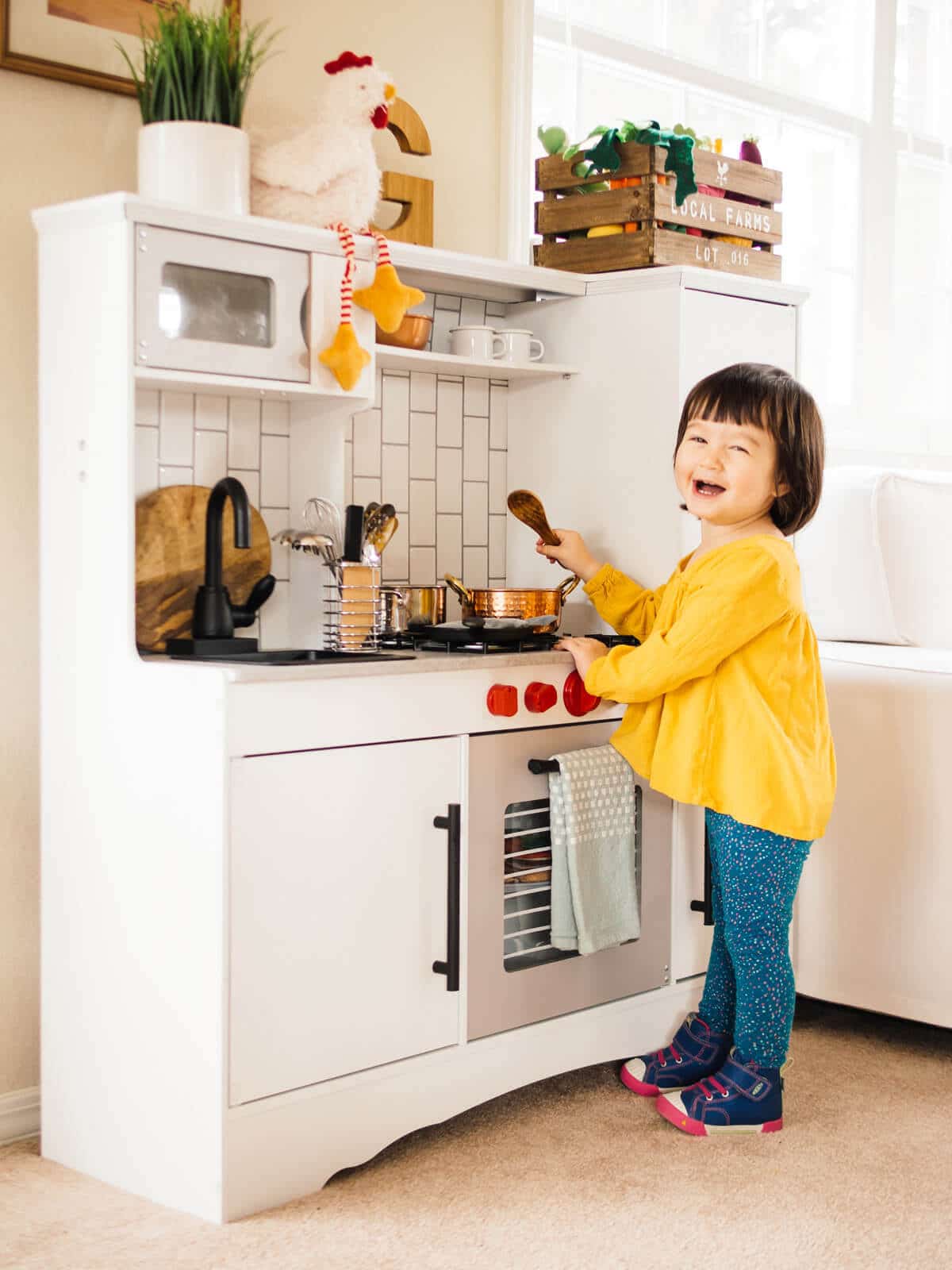When Sarah walked into her daughter Lily’s room one evening, she expected the usual scene: a few stuffed animals scattered across the floor and perhaps a picture book left on the bed. However, tonight, the room had been transformed. In the corner stood a brand-new play kitchen with miniature pots, pans, and even a tiny microwave. Lily was busy “cooking” a feast, stirring an invisible soup while announcing that dinner would be ready in five minutes. With her toy apron tied snugly around her waist and a pretend chef’s hat perched on her head, Lily was in her element. “Mommy, do you want some tea?” she asked proudly.
It was heartwarming for Sarah, but she quickly realized that this was not just play. In that little corner kitchen, Lily practiced real-life skills—improvising, organizing, and problem-solving—all while engaging in rich, imaginative play. Over time, Sarah watched as her daughter’s play kitchen became a central part of her daily routine, inviting creativity, collaboration with friends, and even early lessons in responsibility as she “cleaned” up after each meal.
Like Lily, countless children worldwide engage with play kitchens, a toy that offers far more than mere entertainment. Play kitchens have evolved from simple plastic sets to intricately designed, realistic miniature kitchens that foster creativity and essential developmental skills. Let us dive into the world of play kitchens, their growing popularity, their benefits, and what parents should consider when choosing the right one for their child.
The Growing Popularity of Play Kitchens
Play kitchens have long been a staple in children’s toys, but their popularity has surged as more parents recognize their developmental benefits. According to a 2022 report from Statista, sales of pretend play toys—including play kitchens—rose by 22% from 2019 to 2022, with play kitchens topping the list of the most requested toys by children ages 3 to 7 (Statista, 2022). The rise in popularity can be attributed not only to the nostalgia of parents who had play kitchens as children but also to a growing understanding of these toys’ role in early childhood development.
In a world increasingly dominated by screens, many parents seek toys that encourage hands-on, imaginative play. A 2023 study from The Toy Association found that 65% of parents believe pretend play is more important than ever in fostering creativity and cognitive skills, with 43% explicitly citing play kitchens as an ideal tool for imaginative play (The Toy Association, 2023).
The Developmental Benefits of Play Kitchens
Play kitchens may seem like a simple source of entertainment, but they offer a wide range of developmental benefits for young children. Let us explore how these interactive toys contribute to children’s growth in several key areas.
- Imaginative and Creative Play
At the heart of every play kitchen is the opportunity for children to dive into imaginative play. Kids engage in rich, creative storytelling, Whether pretending to be chefs in a bustling restaurant or simply making breakfast for their stuffed animals. This type of imaginative play is essential for cognitive development as it helps children experiment with different roles, scenarios, and outcomes.
According to child development experts at The American Academy of Pediatrics (AAP), pretend play is critical for children’s social, emotional, and cognitive growth. It encourages creativity, helps children make sense of the world around them, and supports their ability to problem-solve and think critically (AAP, 2023). With a play kitchen, the possibilities for creative play are nearly endless, from inventing new recipes to hosting a pretend dinner party.
- Role-Playing and Social Skills
Play kitchens naturally lend themselves to role-playing, essential for developing social skills. When children play together in the kitchen, they take on different roles—chef, server, or even customer—requiring them to communicate, collaborate, and negotiate. These interactions teach children how to share, take turns, and work together toward a common goal, all essential skills for navigating real-life social situations.
Research from Harvard University’s Center on the Developing Child shows that pretend play, especially in a cooperative setting, helps children develop empathy, self-regulation, and the ability to see things from another person’s perspective (Harvard University, 2022). When kids work together in a play kitchen, they learn to manage disagreements, make decisions, and understand the importance of cooperation.
- Fine Motor Skills and Coordination
Handling the small utensils, pots, and food items that come with a play kitchen provides excellent practice for developing fine motor skills. From turning knobs and opening oven doors to stirring pretend food, these actions require agility and coordination. These seemingly simple tasks help strengthen the muscles in children’s hands and fingers, crucial for later skills like writing and using scissors.
A study published by the Journal of Early Childhood Education in 2022 found that children who regularly engaged in pretend play with tools like play kitchens showed improved fine motor skills compared to those who primarily engaged in passive play (Journal of Early Childhood Education, 2022). The repetitive motions of pretend cooking—stirring, pouring, and using utensils—help children refine their hand-eye coordination.
- Language and Vocabulary Development
Play kitchens are also fantastic tools for language development. As children play, they are constantly exposed to new words and concepts, from the names of foods and utensils to cooking techniques and processes. Whether “baking” a cake or “boiling” water, children learn to associate actions with specific words, expanding their vocabulary.
A 2023 report from PBS Parents highlighted that pretend play scenarios, such as playing in a kitchen, significantly enhance language development in young children. The report found that children exposed to play kitchens showed a 20% increase in using new words after just a few weeks of regular play (PBS Parents, 2023).
Types of Play Kitchens
As the popularity of play kitchens continues to grow, so does the variety of options available to parents. Here are some of the most common types of play kitchens and their features.
- Wooden Play Kitchens
Wooden play kitchens have become increasingly popular due to their durability and aesthetic appeal. Often designed to mimic accurate kitchen layouts, these kitchens feature realistic knobs, shelves, and appliances, giving children the sense of operating a real kitchen. Wooden play kitchens are also eco-friendly and often made from sustainably sourced materials, making them a favorite among environmentally conscious parents.
- Plastic Play Kitchens
Plastic play kitchens are typically more affordable and lightweight than wooden options, making them ideal for younger children or families with limited space. These kitchens often come with bright colors and fun sound effects, creating excitement for younger toddlers. While they may not have the same longevity as wooden kitchens, they are still effective at fostering imaginative play.
- Miniature Kitchenettes
For parents with limited space, miniature play kitchens offer a compact solution. These scaled-down versions often feature the essentials—like a stovetop and sink—without taking up too much room. Despite their smaller size, these kitchens still provide all the interactive play features that larger models offer.
- Themed Play Kitchens
Some play kitchens have specific themes, such as a bakery, pizza parlor, or even a food truck. These themed kitchens are designed to inspire particular types of play, encouraging children to take on more specific roles and scenarios. Themed kitchens often come with unique accessories, such as pizza slices or bakery items, which add to the fun.
Critical Considerations for Choosing a Play Kitchen
When choosing a play kitchen, there are several factors to consider to ensure it meets your child’s needs and interests:
- Age Appropriateness: Look for a play kitchen for your child’s age group. Simpler plastic models may be ideal for younger toddlers, while older children may appreciate the more detailed wooden kitchens.
- Size and Space: Consider the size of the play kitchen and your available space. Some play kitchens can be pretty significant, so measure before purchasing.
- Durability: Opt for high-quality materials like wood if you are looking for a long-lasting toy. Wooden play kitchens can withstand years of play and are less likely to break or wear down over time.
- Safety: Check that the play kitchen is made from non-toxic materials and has no sharp edges or small parts that could be a choking hazard.
Conclusion: A Kitchen for Learning and Fun
Play kitchens offer children more than just a chance to mimic their parents in the kitchen—they provide a rich, interactive environment that fosters creativity, builds essential life skills, and supports physical and cognitive development. As parents continue to recognize the value of hands-on, imaginative play, the play kitchen remains one of the most beloved and educational toys for young children.
Whether stirring a pretend soup or hosting a make-believe dinner party, the play kitchen sparks endless opportunities for fun and learning. With the wide variety of options available, parents can find the perfect play kitchen to inspire their children’s imagination and nurture their growth for years.











